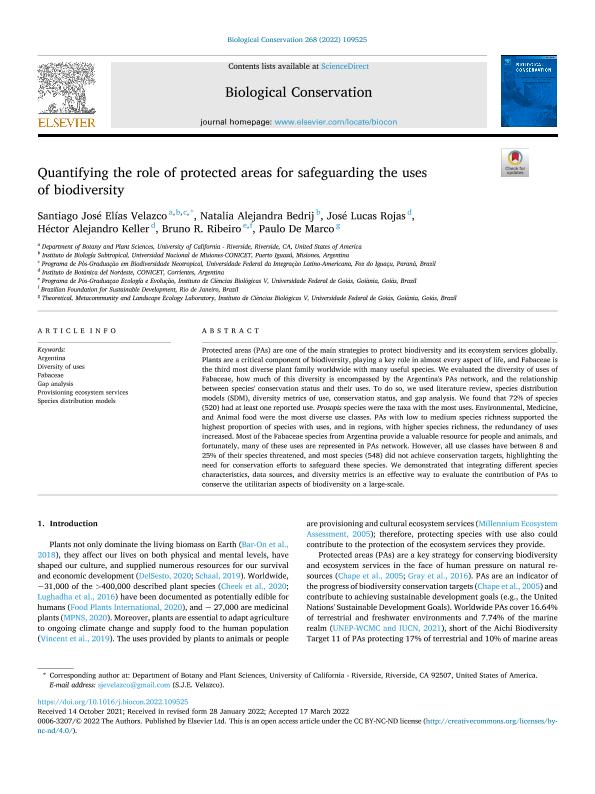Mostrar el registro sencillo del ítem
dc.contributor.author
Velazco, Santiago José Elías

dc.contributor.author
Bedrij, Natalia Alejandra

dc.contributor.author
Rojas, José Lucas

dc.contributor.author
Keller, Hector Alejandro

dc.contributor.author
Ribeiro, Bruno R.
dc.contributor.author
de Marco Junior, Paulo

dc.date.available
2023-08-17T13:34:22Z
dc.date.issued
2022-04
dc.identifier.citation
Velazco, Santiago José Elías; Bedrij, Natalia Alejandra; Rojas, José Lucas; Keller, Hector Alejandro; Ribeiro, Bruno R.; et al.; Quantifying the role of protected areas for safeguarding the uses of biodiversity; Elsevier; Biological Conservation; 268; 109525; 4-2022; 1-8
dc.identifier.issn
0006-3207
dc.identifier.uri
http://hdl.handle.net/11336/208594
dc.description.abstract
Protected areas (PAs) are one of the main strategies to protect biodiversity and its ecosystem services globally. Plants are a critical component of biodiversity, playing a key role in almost every aspect of life, and Fabaceae is the third most diverse plant family worldwide with many useful species. We evaluated the diversity of uses of Fabaceae, how much of this diversity is encompassed by the Argentina's PAs network, and the relationship between species' conservation status and their uses. To do so, we used literature review, species distribution models (SDM), diversity metrics of use, conservation status, and gap analysis. We found that 72% of species (520) had at least one reported use. Prosopis species were the taxa with the most uses. Environmental, Medicine, and Animal food were the most diverse use classes. PAs with low to medium species richness supported the highest proportion of species with uses, and in regions, with higher species richness, the redundancy of uses increased. Most of the Fabaceae species from Argentina provide a valuable resource for people and animals, and fortunately, many of these uses are represented in PAs network. However, all use classes have between 8 and 25% of their species threatened, and most species (548) did not achieve conservation targets, highlighting the need for conservation efforts to safeguard these species. We demonstrated that integrating different species characteristics, data sources, and diversity metrics is an effective way to evaluate the contribution of PAs to conserve the utilitarian aspects of biodiversity on a large-scale.
dc.format
application/pdf
dc.language.iso
eng
dc.publisher
Elsevier

dc.rights
info:eu-repo/semantics/openAccess
dc.rights.uri
https://creativecommons.org/licenses/by-nc-nd/2.5/ar/
dc.subject
ARGENTINA
dc.subject
DIVERSITY OF USES
dc.subject
FABACEAE
dc.subject
GAP ANALYSIS
dc.subject
PROVISIONING ECOSYSTEM SERVICES
dc.subject
SPECIES DISTRIBUTION MODELS
dc.subject.classification
Conservación de la Biodiversidad

dc.subject.classification
Ciencias Biológicas

dc.subject.classification
CIENCIAS NATURALES Y EXACTAS

dc.title
Quantifying the role of protected areas for safeguarding the uses of biodiversity
dc.type
info:eu-repo/semantics/article
dc.type
info:ar-repo/semantics/artículo
dc.type
info:eu-repo/semantics/publishedVersion
dc.date.updated
2023-07-07T22:04:17Z
dc.journal.volume
268
dc.journal.number
109525
dc.journal.pagination
1-8
dc.journal.pais
Países Bajos

dc.journal.ciudad
Amsterdam
dc.description.fil
Fil: Velazco, Santiago José Elías. Consejo Nacional de Investigaciones Científicas y Técnicas. Centro Científico Tecnológico Conicet - Nordeste. Instituto de Biología Subtropical. Instituto de Biología Subtropical - Nodo Puerto Iguazú | Universidad Nacional de Misiones. Instituto de Biología Subtropical. Instituto de Biología Subtropical - Nodo Puerto Iguazú; Argentina. University of California; Estados Unidos. Universidade Federal da Integração Latino-Americana; Brasil
dc.description.fil
Fil: Bedrij, Natalia Alejandra. Consejo Nacional de Investigaciones Científicas y Técnicas. Centro Científico Tecnológico Conicet - Nordeste. Instituto de Biología Subtropical. Instituto de Biología Subtropical - Nodo Puerto Iguazú | Universidad Nacional de Misiones. Instituto de Biología Subtropical. Instituto de Biología Subtropical - Nodo Puerto Iguazú; Argentina
dc.description.fil
Fil: Rojas, José Lucas. Consejo Nacional de Investigaciones Científicas y Técnicas. Centro Científico Tecnológico Conicet - Nordeste. Instituto de Botánica del Nordeste. Universidad Nacional del Nordeste. Facultad de Ciencias Agrarias. Instituto de Botánica del Nordeste; Argentina
dc.description.fil
Fil: Keller, Hector Alejandro. Consejo Nacional de Investigaciones Científicas y Técnicas. Centro Científico Tecnológico Conicet - Nordeste. Instituto de Botánica del Nordeste. Universidad Nacional del Nordeste. Facultad de Ciencias Agrarias. Instituto de Botánica del Nordeste; Argentina
dc.description.fil
Fil: Ribeiro, Bruno R.. Universidade Federal de Goiás; Brasil. Brazilian Foundation for Sustainable Development; Brasil
dc.description.fil
Fil: de Marco Junior, Paulo. Universidade Federal de Goiás; Brasil
dc.journal.title
Biological Conservation

dc.relation.alternativeid
info:eu-repo/semantics/altIdentifier/url/https://www.sciencedirect.com/science/article/pii/S0006320722000787
dc.relation.alternativeid
info:eu-repo/semantics/altIdentifier/doi/http://dx.doi.org/10.1016/j.biocon.2022.109525
Archivos asociados
